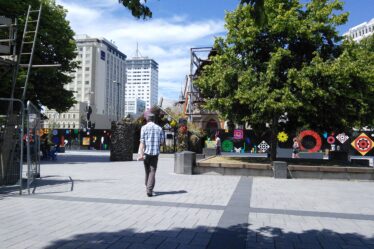Milford Sound was something of an epic adventure.
After a four hour drive, our first stop was in the town of Te Anau. We quickly found no short walks in the area appealed to us and instead went to a film showing in the local cinema. The film, Ata Whenua (Maori for Shadowland), was the brainchild of a helicopter pilot from the region. He had realised he was one of very few that was able to experience most, though still not all, that the Fiordland region had to offer.
Fiordland is the most south westerly region of New Zealand and is three million acres in size (this is bigger than Yellowstone and Yosemite National Parks combined). Most of the land has been untouched by humans, the terrain making it inaccessible to all but the likes of helicopters and extreme climbers.
The reasoning for the term Shadowland became clear as we left Te Anau and made our way further west toward Milford Sound. The foreground was awash with colour, bright greens and yellows, while the mountainous backdrop, shrouded in cloud, was a blue grey silhouette. Brightness was apparent only in snow, specked here and there among summits.

We were staying in Cascade Creek campsite ahead of our boat trip the following morning. A huge space at the base of mountains, the only cover was within trees at one edge. It was to be a cold night, temperatures around 1° or 2° when we checked the following morning. This, accompanied by continual rain, was not quite the summer weather everyone in England had been advising my Dad it would be!
Our drive to Milford Sound that morning was breathtaking, passing through snow capped mountains (which we later discovered were from a fresh snowfall the previous night), as we drove through the valley base. The road led into a tunnel, a hole cut through the side of a mountain, with a visibly rocky interior.

There were definitely perks to the rainy weather, made apparent once our boat trip began. Milford Sound had only two permanent waterfalls, any others which appear are a product of recent rainfall. A week and half of constant rain can produce up to 20,000 waterfalls!
The few other boats we passed made things a little more touristy, but also added a great perspective to our surroundings. A large ship looked nothing more than a small toy, next to gushing waterfalls and towering cliff walls.
Our journey was nothing if not eventful, our skipper driving the boat under waterfalls to collect cups of rainwater for us to drink and to fully soak anyone who dared to stand outside. We were also met with stormy weather as we began our return leg just before reaching the Tasman Sea, hailstone cascading down on us as wind and waves had everyone grasping for support.
It had been a long drive to include Milford Sound in our travels, but we were really glad we had made the journey. It was a once in a lifetime kind of event. We were both more than happy to stand in silence as the boat glided between mountains decorated with waterfalls, greenery and at the utmost points, glistening snow.

Our drive back to civilisation was nearly as eventful as the boat trip. Waiting at traffic lights to pass back through the rocky hole in the mountain (aka tunnel), the campervan driver in front seemed less than able to make their vehicle go forwards. It took some reversing, some serious steering and a little holding of breaths for us to squeeze past before they backed right into us!
Other than that, our journey north began in a nice, sedate fashion.



